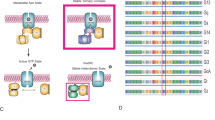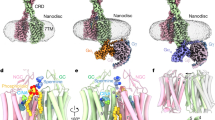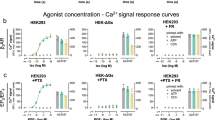Abstract
The activation of a guanine nucleotide binding (G) protein is an essential step in coupling certain receptors to the inhibition of voltage-activated calcium channels1–3. We have previously observed that analogues of GTP potentiate the effect of receptor agonists and inhibit calcium currents in cultured dorsal root ganglion (DRG) neurones2,4. A residual sustained 'L-type' component5 of the calcium channel current is resistant to inhibition by internal guanosine 5′-O-3-thiotriphosphate (GTP-γ-S)4. Because calcium channel antagonists such as D600, nifedipine and diltiazem6,7 inhibit L currents5,8,9, we examined their effect on GTP-γ-S-modified currents. These compounds all produced a rapid and very marked potentiation of calcium channel currents in the presence of internal GTP-γ-S and this effect was prevented by pertussis toxin which ADP ribosylates the G proteins Gi/G0 (for review see ref. 10). We suggest that this potentiation indicates that activated G protein can interact with the calcium channel, and that this enhances the action of calcium channel ligands at their agonist sites on the channel in its resting state11,12. These results represent the first electrophysiological evidence that guanine nucleotides are able to influence cellular responses to calcium channel ligands.
This is a preview of subscription content, access via your institution
Access options
Subscribe to this journal
Receive 51 print issues and online access
$199.00 per year
only $3.90 per issue
Buy this article
- Purchase on SpringerLink
- Instant access to full article PDF
Prices may be subject to local taxes which are calculated during checkout
Similar content being viewed by others
References
1. Holz, G. G., Rane, S. G. & Dunlap, K. Nature 319, 670-672 (1986). 2. Scott, R. H. & Dolphin, A. C. Neurosci. Lett. 56, 59-64 (1986). 3. Hescheler, J., Rosenthal, W., Trautwein, W. & Schultz, G. Nature 325, 445-447 (1987). 4. Dophin, A. C. & Scott, R. H. / Physiol, Lond. 386, 1-17 (1987). 5. Nowycky, M. C., Fox, A. P. & Tsien, R. W. Nature 316, 440-443 (1985). 6. Striessnig, J., Goll, A., Moosburger, K. & Glossman, H. FEES Lett. 197, 204-210 (1986). 7. Triggle, D. J., Skattebol, A., Rampe, D., Joslyn, A. & Gengo, P. in New Insights into cell and membrane transport processes, (eds Poste, G. & Crooke, S. T.) 125-142 (Plenum, New York, 1986). 8. Lee, K. S. & Tsien, R. W. Nature 302, 790-794 (1983). 9. Hess, P., Lansman, J. B. & Tsien, R. W. Nature 311, 538-544 (1984). 10. Dolphin, A. C. Trends Neurosci. 10, 53-57 (1987). 11. Nowycky, M.C., Fox, A. P. & Tsien, R.W. Proc. natn.Acad.Sci. U.S.A. 82,2178-2184 (1985). 12. Brown, A. M., Kunze, D. L. & Yatani, A. Nature 311, 570-572 (1984). 13. Fox, A. P., Nowycky, M. C. & Tsien, R. W. /. Physiol., Lond. 394, 149-172 (1987). 14. Dolphin, A. C. & Scott, R. H. Br. J. Pharmac. 90, 14P (1987). 15. Rogart, R. B., DeBruyn Kops, A. & Dzau, V. J. Proc. natn. Acad. Sci. U.S.A. 83, 7452-7456 (1986). 16. Brown, A. M., Kunze, D. L. & Yatani, A. / Physiol, Lond. 379, 495-514 (1986). 17. Galizzi, J.-P., Fosset, M. & Lazdunski, M. Eur. J. Biochem. 144, 211-215 (1984). 18. Dolphin, A. C., Scott, R. H., Trentham, D. R. & Wootton, J. F. /. Physiol., Lond. 390, 89P (1987). 19. Huff, R. M. & Neer, E. J. /. biol Chem. 261, 1105-1110 (1986). 20. Jakobs, K. H., Aktories, K. & Schultz, G. Eur. J. Biochem. 140, 177-181 (1984). 21. Murayama, T., Katada, T. & Ui, M. Archs Biochem. Biophys. 221, 381-390 (1983). 22. Bean, B. P. Proc. natn. Acad. Sci. U.S.A. 81, 6388-6392 (1984). 23. Schwartz, A., Grupp, I., Grupp, G., Williams, J. & Vaghy, P. Biochem. biophys. Res. Commun. 125, 387-394 (1984). 24. Miller, R. J. Science 235, 46-52 (1987). 25. Lewis, D. L., Weight, F. F. & Luini, A. Proc. natn. Acad. Sci. U.S.A. 83, 9035-9039 (1986).
Author information
Authors and Affiliations
Rights and permissions
About this article
Cite this article
Scott, R., Dolphin, A. Activation of a G protein promotes agonist responses to calcium channel ligands. Nature 330, 760–762 (1987). https://doi.org/10.1038/330760a0
Received:
Accepted:
Issue date:
DOI: https://doi.org/10.1038/330760a0
This article is cited by
-
Slow inhibition of N-type calcium channels with GTPγS reflects the basal G protein-GDP turnover rate
Pflügers Archiv - European Journal of Physiology (2003)
-
Expression of the L-type calcium channel with two different ? subunits and its modulation by Ro 40-5967
Pfl�gers Archiv European Journal of Physiology (1995)
-
GABAB receptors and G proteins modulate voltage-dependent calcium channels in cultured rat dorsal root ganglion neurons: Relevance to transmitter release and its modulation
Neurophysiology (1995)



